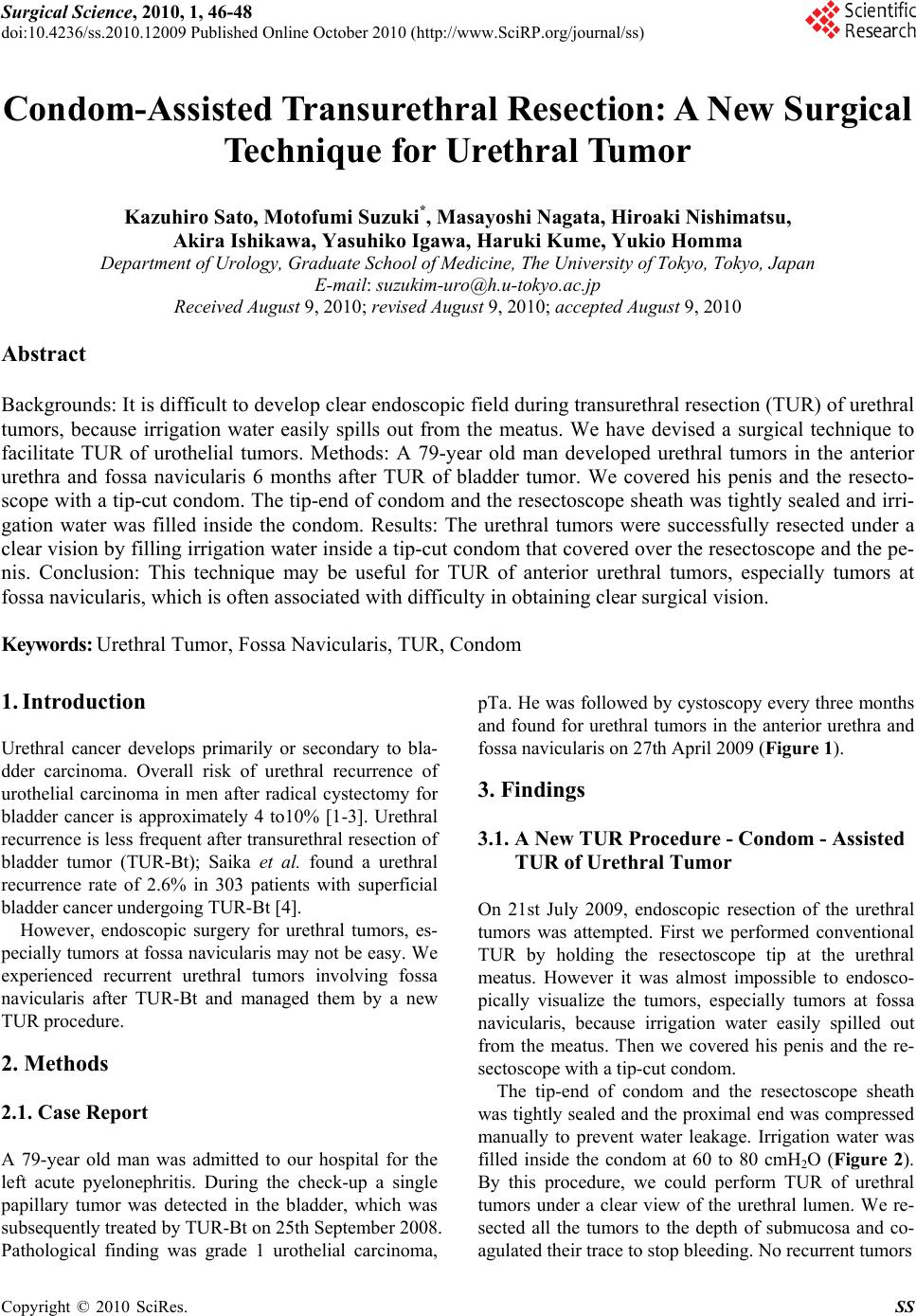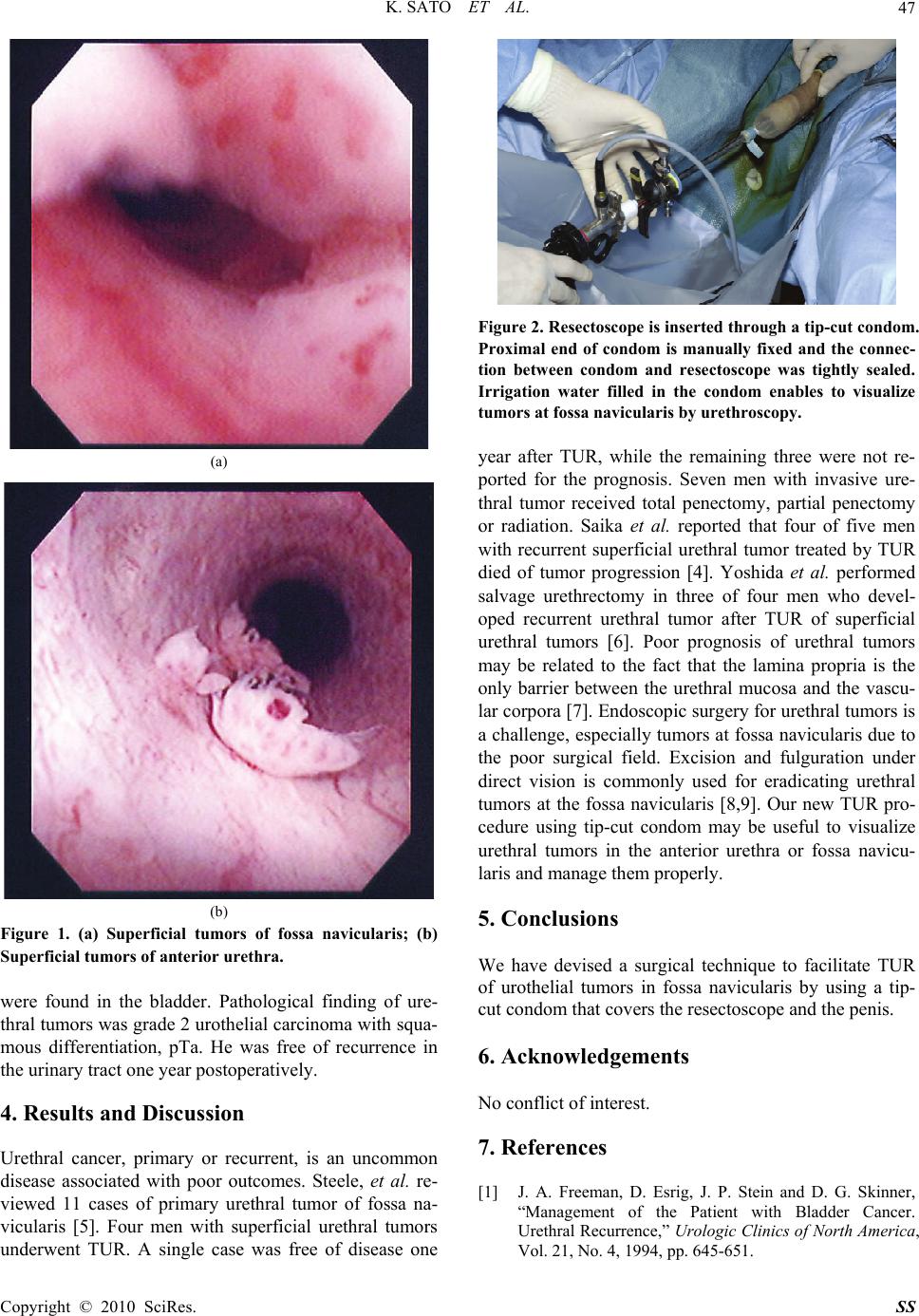Paper Menu >>
Journal Menu >>
 Surgical Science, 2010, 1, 46-48 doi:10.4236/ss.2010.12009 Published Online October 2010 (http://www.SciRP.org/journal/ss) Copyright © 2010 SciRes. SS Condom-Assisted Transurethral Resection: A New Surgical Technique for Urethral Tumor Kazuhiro Sato, Motofumi Suzuki*, Masayoshi Nagata, Hiroaki Nishimatsu, Akira Ishikawa, Yasuhiko Igawa, Haruki Kume, Yukio Homma Department of Urology, Graduate School of Medicine, The University of Tokyo, Tokyo, Japan E-mail: suzukim-uro@h.u-tokyo.ac.jp Received August 9, 2010; revised August 9, 2010; accepted August 9, 2010 Abstract Backgrounds: It is difficult to develop clear endoscopic field during transurethral resection (TUR) of urethral tumors, because irrigation water easily spills out from the meatus. We have devised a surgical technique to facilitate TUR of urothelial tumors. Methods: A 79-year old man developed urethral tumors in the anterior urethra and fossa navicularis 6 months after TUR of bladder tumor. We covered his penis and the resecto- scope with a tip-cut condom. The tip-end of condom and the resectoscope sheath was tightly sealed and irri- gation water was filled inside the condom. Results: The urethral tumors were successfully resected under a clear vision by filling irrigation water inside a tip-cut condom that covered over the resectoscope and the pe- nis. Conclusion: This technique may be useful for TUR of anterior urethral tumors, especially tumors at fossa navicularis, which is often associated with difficulty in obtaining clear surgical vision. Keywords: Urethral Tumor, Fossa Navicularis, TUR, Condom 1. Introduction Urethral cancer develops primarily or secondary to bla- dder carcinoma. Overall risk of urethral recurrence of urothelial carcinoma in men after radical cystectomy for bladder cancer is approximately 4 to10% [1-3]. Urethral recurrence is less frequent after transurethral resection of bladder tumor (TUR-Bt); Saika et al. found a urethral recurrence rate of 2.6% in 303 patients with superficial bladder cancer undergoing TUR-Bt [4]. However, endoscopic surgery for urethral tumors, es- pecially tumors at fossa navicularis may not be easy. We experienced recurrent urethral tumors involving fossa navicularis after TUR-Bt and managed them by a new TUR procedure. 2. Methods 2.1. Case Report A 79-year old man was admitted to our hospital for the left acute pyelonephritis. During the check-up a single papillary tumor was detected in the bladder, which was subsequently treated by TUR-Bt on 25th September 2008. Pathological finding was grade 1 urothelial carcinoma, pTa. He was followed by cystoscopy every three months and found for urethral tumors in the anterior urethra and fossa navicularis on 27th April 2009 (Figure 1). 3. Findings 3.1. A New TUR Procedure - Condom - Assisted TUR of Urethral Tumor On 21st July 2009, endoscopic resection of the urethral tumors was attempted. First we performed conventional TUR by holding the resectoscope tip at the urethral meatus. However it was almost impossible to endosco- pically visualize the tumors, especially tumors at fossa navicularis, because irrigation water easily spilled out from the meatus. Then we covered his penis and the re- sectoscope with a tip-cut condom. The tip-end of condom and the resectoscope sheath was tightly sealed and the proximal end was compressed manually to prevent water leakage. Irrigation water was filled inside the condom at 60 to 80 cmH2O (Figure 2). By this procedure, we could perform TUR of urethral tumors under a clear view of the urethral lumen. We re- sected all the tumors to the depth of submucosa and co- agulated their trace to stop bleeding. No recurrent tumors  K. SATO ET AL. Copyright © 2010 SciRes. SS 47 (a) (b) Figure 1. (a) Superficial tumors of fossa navicularis; (b) Superficial tumors of anterior urethra. were found in the bladder. Pathological finding of ure- thral tumors was grade 2 urothelial carcinoma with squa- mous differentiation, pTa. He was free of recurrence in the urinary tract one year postoperatively. 4. Results and Discussion Urethral cancer, primary or recurrent, is an uncommon disease associated with poor outcomes. Steele, et al. re- viewed 11 cases of primary urethral tumor of fossa na- vicularis [5]. Four men with superficial urethral tumors underwent TUR. A single case was free of disease one Figure 2. Resectoscope is inserted through a tip-cut condom. Proximal end of condom is manually fixed and the connec- tion between condom and resectoscope was tightly sealed. Irrigation water filled in the condom enables to visualize tumors at fossa navicularis by urethroscopy. year after TUR, while the remaining three were not re- ported for the prognosis. Seven men with invasive ure- thral tumor received total penectomy, partial penectomy or radiation. Saika et al. reported that four of five men with recurrent superficial urethral tumor treated by TUR died of tumor progression [4]. Yoshida et al. performed salvage urethrectomy in three of four men who devel- oped recurrent urethral tumor after TUR of superficial urethral tumors [6]. Poor prognosis of urethral tumors may be related to the fact that the lamina propria is the only barrier between the urethral mucosa and the vascu- lar corpora [7]. Endoscopic surgery for urethral tumors is a challenge, especially tumors at fossa navicularis due to the poor surgical field. Excision and fulguration under direct vision is commonly used for eradicating urethral tumors at the fossa navicularis [8,9]. Our new TUR pro- cedure using tip-cut condom may be useful to visualize urethral tumors in the anterior urethra or fossa navicu- laris and manage them properly. 5. Conclusions We have devised a surgical technique to facilitate TUR of urothelial tumors in fossa navicularis by using a tip- cut condom that covers the resectoscope and the penis. 6. Acknowledgements No conflict of interest. 7. References [1] J. A. Freeman, D. Esrig, J. P. Stein and D. G. Skinner, “Management of the Patient with Bladder Cancer. Urethral Recurrence,” Urologic Clinics of North America, Vol. 21, No. 4, 1994, pp. 645-651.  K. SATO ET AL. Copyright © 2010 SciRes. SS 48 [2] J. P. Stein, P. Clark, G. Miranda, et al., “Urethral Tumor Recurrence Following Cystectomy and Urinary Diver- sion: Clinical and Pathological Characteristics in 768 Male Patients,” Journal of Urology, Vol. 173, No. 4, 2005, pp. 1163-1168. [3] K. S. Cho, J. W. Seo, Y. H. Lee, et al., “The Risk Factor for Urethral Recurrence after Radical Cystectomy in Patients with Transitional Cell Carcinoma of the Bladder,” Urology International, Vol. 82, No. 3, 2009, pp. 306-311. [4] T. Saika, T. Tsushima, Y. Nasu, et al., “Anterior Urethral Recurrence of Superficial Bladder Cancer: Its Clinical Significance,” Acta Medica Okayama, Vol. 57, No. 6, 2003, pp. 293-297. [5] G. S. Steele, J. R. Fielding, A. Renshaw, et al., “Transi- tional Cell Carcinoma of the fossa Navicularis,” Urology, Vol. 50, No. 5, 1997, pp. 792-795. [6] K. Yoshida, H. Nishiyama, H. Kinoshita, et al., “Surgical Treatment for Urethral Recurrence after Ileal Neobladder Reconstruction in Patients with Bladder Cancer,” BJU International, Vol. 98, No. 5, 2006, pp. 1008-1011. [7] D. P. Hickey, M. S. Soloway and W. M. Murphy, “Selec- tive Urethrectomy Following Cystoprostatectomy for Bladder Cancer,” Journal of Urology, Vol. 136, No. 4, 1986, pp. 828-830. [8] R. A. Mevorach, L. R. Cos, P. A. di Sant’Agnese and M. Stoler, “Human Papilloma Virus Type 6 in Grade 1 Transitional Cell Carcinoma of the Urethra,” Journal of Urology, Vol. 143, No. 1, 1990, pp. 126-128. [9] L. H. Stewart and S. R. Johnston, “Transitional Cell Car- cinoma of the Fossa Navicularis,” British Journal of Urology, Vol. 72, No. 1, 1993, pp. 121-122. |

